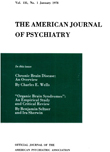Pseudoepilepsy: a study in adolescent hysteria
Abstract
Of 19 adolescents with diagnosed psychogenic seizures, 13 had hysterical convulsions and 4 had amnesiac fugues. Sixteen of the patients were given a diagnosis of hysterical neurosis; 2, process schizophrenia; and 1, borderline psychosis. Thirteen of the patients were initially diagnosed incorrectly as having epilepsy and were treated for an average of 15 months with anticonvulsant medication. The therapist should always consider the possibility of psychogenic factors in children and adolescents who suffer from seizures.
Access content
To read the fulltext, please use one of the options below to sign in or purchase access.- Personal login
- Institutional Login
- Sign in via OpenAthens
- Register for access
-
Please login/register if you wish to pair your device and check access availability.
Not a subscriber?
PsychiatryOnline subscription options offer access to the DSM-5 library, books, journals, CME, and patient resources. This all-in-one virtual library provides psychiatrists and mental health professionals with key resources for diagnosis, treatment, research, and professional development.
Need more help? PsychiatryOnline Customer Service may be reached by emailing [email protected] or by calling 800-368-5777 (in the U.S.) or 703-907-7322 (outside the U.S.).



